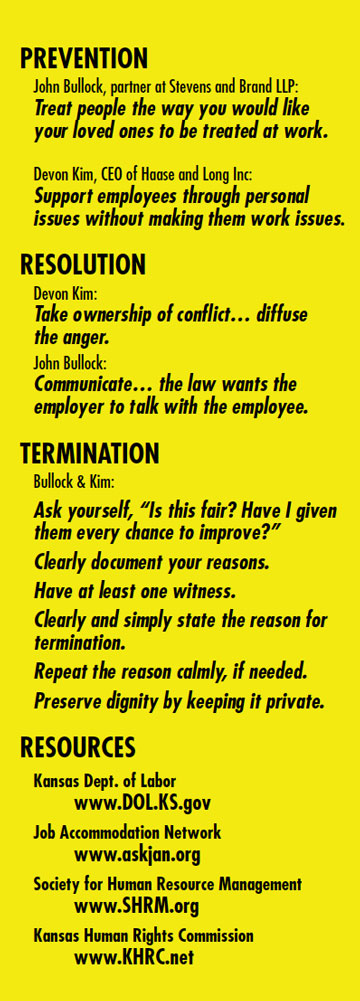Keys to maintaining a conflict-free workplace include prevention practices and open communication.
| 2018 Q1 | story by Julie Dunlap | photos by Steven Hertzog

When it comes to managing employees, whether one or 1,000, Lawrence attorney John Bullock offers simple yet sage advice: “Treat people the way you would like your loved ones to be treated at work.”
This seemingly clear and easy-to-follow guideline is not always clear and easy to follow as any given workday ticks on. Personal issues may seep into the workplace; misunderstandings may arise; poor judgment among employees and superiors may create an atmosphere in need of intervention in order to regain and retain harmony and productivity.
“I’d prefer they call me before legal issues arise,” says Bullock, who has spent the past nine years of his law career practicing with Stevens and Brand, LLP, in Lawrence.
Fortunately, there are a number of steps employers and employees can take to prevent a conflict from escalating to a level that would require outside-and often costly-intervention, starting with clear and open communication.
Employers are required by law to display posters (available for free on the Kansas Department of Labor website: www.dol.ks.gov) informing employees about such rights and issues as workers compensation, equal opportunity employment and unemployment insurance, among others. But, posting state and federal regulations is just the beginning of creating a harmonious work environment.

John Bullock, partner at the law firm Stevens & Brand, LLP
Bullock strongly recommends every company owner have a clearly written and frequently updated employee handbook. Outlining company policies, job responsibilities, standards of conduct, procedures for filing grievances, compensation policies and other pertinent information can keep employees and their superiors on the same page, and moving in the same direction in their day-to-day operations. Bullock and his team regularly assist companies with the creation, implementation and updating of employee handbooks to ease the often daunting process. While hiring an attorney is primarily seen as a last line of defense, Bullock would strongly prefer to counsel clients on ways to prevent discord in the workplace.
Of course, any handbook is only as effective as the people who commit to following it. “Be honest, fair, and firm,” Bullock emphasizes.
Every company will experience different successes and challenges. Bullock notes that larger companies are often more likely to have a stronger set of written policies but may face more challenges in regularly reaching managers and supervisors to keep them up-to-date in their training. He recommends having systems in place to help managers stay on top of communication. Conversely, smaller companies may have a shorter chain of command and more frequent and direct verbal communication lines naturally in place, but they may also more easily allow written documentation to lapse.
Regardless of company size, Bullock stresses the importance of regular employee reviews and accurate documentation, with evaluations and communication recorded in writing. If an employee is having an issue that negatively affects his or her performance, the manager should document the issue and the employee’s progress in correcting it. This documentation will aide greatly should the decision ultimately be made to terminate employment.
“The [documentation]has to match the story,” he says, explaining that an employer who is accused of wrongly terminating or demoting an employee will have a much harder time proving the action was reasonable if the employee’s file is filled with glowing reviews.
Likewise, Bullock recommends employees maintain documentation of their own. Anytime an employee meets a quota, earns recognition, asks for assistance, files a complaint or has any other positive or negative issue, the employee is best served by both keeping a personal record and asking the employer to keep a written copy of the event in his or her employment file.

Devon Kim. owner of of Hasse and Long Inc.
While many situations can affect a work environment, Bullock says an increasing number of the cases he sees arise from the impact an employee’s medical (both physical and mental) issues have on the employee’s ability to carry out the assigned job duties. These situations can often be resolved with open communication and thoroughly researching ways to accommodate the change in an employee’s ability to perform.
“I’ve seen the interactive process work many times,” Bullock says, “when you have an employee who can’t do what she used to be able to do; but we can find another position for her, or we can adjust her hours of work, or we can provide office furniture or electronic equipment, or other means that help that person be productive.”
He adds, “The purpose of the law is that people who are differently abled should be able to work and should not be discriminated against.”
Employers will find a number of potential accommodations and other resources through the Job Accommodation Network (www.askJAN.org), an organization committed to “helping people with disabilities enhance their employability.”
Medical issues may be an increasing root of conflict crossing Bullock’s desk, but a number of other situations are common, as well, such as bringing sexual content to the office, whether it be through images or comments. “That stuff does not play well in a courtroom,” Bullock says emphatically.
Another common situation is one Bullock summarizes as a lack of civility. “These interactions are not always illegal, in that employment laws are not a general civility code,” he says. But, he explains, bad behavior motivated by antagonizing a protected class, such as race or gender, can be considered creating a “hostile work environment,” which is unlawful.
“There are also legal protections against the intentional infliction of emotional distress,” Bullock adds.
Fortunately, many resources abound to assist employers and employees in resolving these, and other, work-related situations. The legal regulations, standards and guidance outlined in the Americans with Disabilities Act (ADA), Family and Medical Leave Act (FMLA), Equal Employment Opportunity Commission (EEOC) and Workers Compensation-all of which can be found on the Kansas Department of Labor website-should be the first stop one takes in finding the answers to questions related to employment law.
Employment claims can require an employer to pay defense costs ranging from $4,000 up to $150,000, not including damages and attorney’s fees recovered by a successful claimant. A federal lawsuit can last two years, sometimes longer.
And in the end?

“Most settlements are mutually unsatisfactory,” Bullock laments, highlighting the importance of all parties trying to resolve the conflict internally before resorting to legal resolution.
Not all workplace conflicts arise between employees and employers, however. Coworkers often have conflicts among themselves, which can be rather muddy territory for a supervisor to navigate. “As soon as an employee complains about a coworker to the supervisor,” Bullock says, “it becomes the company’s problem.”
Devon Kim, CEO of Haase and Long Inc., a Lawrence-based financial advocacy and mediation company, agrees. Kim, who has served as CEO for the past 14 years, has used her skills, honed in her job description of mediating between medical patients and providers, to promote and preserve harmony within her own staff.
“Oftentimes, I’m mediating, but people don’t realize I am mediating,” Kim confesses.
Reasons for a supervisor to intervene in employee-employee conflicts vary, but the common denominator is one employee consistently doing or saying something that makes another employee uncomfortable, and affects his or her ability to perform the job duties.
Kim prefers to give her employees the tools needed to resolve conflict on their own, empowering them with proper language to help diffuse a situation. “I give them the words to use,” she explains. “Something as simple as, ‘I’m working on [a project]and can’t talk to you right now,’ can diffuse a situation quickly.”
Employees can use strategies such as this as often as needed without further intervention from their supervisors. The success even carries through into their personal lives, a gift employers can give employees that transcends any annual bonus in the long run. “Teaching people how to stand up for themselves appropriately and with finite results,” Kim says, makes them stronger employees and humans.
She has another tool her company uses to maximize potential success. The Culture Index survey, administered by Mea Austin (www.MeaAustin.com), is a part of the application process at Haase and Long. Applicants complete a survey that identifies how their personalities best suit specific jobs within the company. Strong risk-takers, for example, may be excellent candidates for sales and leadership roles, while strict rule-followers may find more satisfaction and success working with clients in need. These aren’t necessarily traits that will shine on a resume or even in a job interview, but by matching employees with duties that tap into their unique skills and passions, Kim has found they can better maximize employees’ potential and job fulfillment.
As Bullock suggests, Kim also has a detailed employee handbook with clear explanations on employee rights and responsibilities on issues ranging from timeliness to when and how it is permitted to sell Girl Scout cookies (one email, one post in the break room, no desk-to-desk sales).
In spite of everything available in writing, though, Kim agrees with Bullock that the best way to avoid misunderstanding and conflict is for employees and supervisors to communicate clearly and frequently, citing a recent example when an employee was planning for maternity leave. Haase and Long has fewer than 51 full-time employees and, therefore, is not subject to all of the regulations governed by the FMLA that typically protect maternity leave in larger companies.
“[The employee] came to me with a clear, complete plan of when she would be gone and how she planned to ease back in after the baby was born,” Kim recalls. “I thanked her and told her this was the most helpful thing she could have done,” she continues, saying that by opening the communication channels, there were no misunderstandings or questions when the time came for the employee to take her leave, and everything was ready for her at the office when she returned.
Bullock, too, sees the positive in the workplace. “Mostly, people are decent; they hire people they think will be successful,” he says, reiterating that the key to any successful company is to “have an open environment for communication.”

87 Comments
http://stromectol1st.shop/# ivermectin buy online
buy prescription drugs from india
paxlovid for sale: buy here – paxlovid covid
http://paxlovid1st.shop/# paxlovid buy
cheap pills online
ivermectin 0.1 stromectol 1st ivermectin generic name
ivermectin 0.5: best price shop – stromectol cream
paxlovid cost without insurance: best price on pills – paxlovid covid
https://paxlovid1st.shop/# paxlovid for sale
natural drugs for ed
https://stromectol1st.shop/# buy oral ivermectin
Online medicine order
Plavix 75 mg price best price on generic Plavix 75 mg price
minocycline 100 mg tablet: buy online – minocycline uses
Semaglutide pharmacy price: rybelsus – semaglutide
paxlovid price paxlovid shop paxlovid for sale
http://stromectol1st.shop/# stromectol 3 mg
pharmacy website india
stromectol drug: buy online – minocycline 50mg for sale
жалгыз акку текст аккорды, жалгыз акку
песня курбан айт эссе, курбан айт казахстан отраслевое соглашение
мз рк, отраслевое соглашение в нефтегазовой отрасли рк 2023 ютуб музыка, ютуб вход
ivermectin canada: best price shop – stromectol pill
ivermectin price canada: cheapest stromectol – stromectol xl
https://stromectol1st.shop/# buy stromectol
buy prescription drugs from india
1xbet зеркало 1xbet 1хбет
https://1winindia.tech/# пин ап казино вход
пинап
en iyi casino siteleri: h?zl? casino – guvenilir casino siteleri
https://1winindia.tech/# pin up kz
pin up kz
en iyi casino siteleri: casino siteleri – en iyi casino siteleri
1xbet скачать: 1xbet – 1хставка
пин ап официальный сайт: пин ап официальный сайт – пин ап вход
пин ап казино вход пин ап казино вход пин ап казино вход
pin-up casino giris: pin up casino – pin-up casino giris
pin up: pin-up – pin up
http://1winrussia.online/# 1xbet скачать
пин ап казино
пин ап казино: пинап кз – pin up
casino sitesi: canl? casino siteleri – slot casino siteleri
http://1winindia.tech/# пинап
пинап
pin-up pin up 306 pin up 306
pin up 306: pin-up casino giris – pin-up
1xbet официальный сайт: 1xbet зеркало – 1хставка
The free Cam to Cam starting credit is worth it! With this gift you can convince yourself of the quality of the free show room and have a look around without obligation.
пин ап: пин ап зеркало – пин ап официальный сайт
slot casino siteleri: slot casino siteleri – h?zl? casino
canl? casino siteleri: canl? casino siteleri – casino siteleri
https://1winindia.tech/# pin up kz
пин ап казино вход
пин ап вход: пинап зеркало – пин ап официальный сайт
pin up azerbaycan: pin up azerbaycan – pin up azerbaycan
1хставка 1xbet скачать 1хставка
magnificent issues altogether, you just gained a brand new
reader. What would you recommend about your submit that you made some days in the past?
Any sure?
пинап казино: пинап казино – пин ап кз
http://1winrussia.online/# 1xbet
пинап кз
пин ап официальный сайт: пин ап зеркало – пин ап зеркало
1хставка: 1хбет – 1хбет
cazino: en iyi casino siteleri – cazino
пин ап казино пин ап кз pin up
1xbet: 1xbet скачать – 1xbet скачать
http://1winindia.tech/# пин ап кз
пинап казино
пин ап зеркало: пин ап – пинап зеркало
cazino: cazino – canl? casino
пин ап казино: пин ап кз – пинап кз
пин ап зеркало пинап зеркало пин ап официальный сайт
https://1winbrasil.win/# pin up
пин ап кз
1xbet: 1хбет – 1xbet скачать
пин ап казино: пин ап кз – пинап кз
пин ап вход: пин ап – пин ап вход
https://1wintr.fun/# en iyi casino siteleri
pin up kz
ed medication online treating ed mens erection pills
http://mexicanpharm1st.com/# п»їbest mexican online pharmacies
medication from mexico pharmacy: mexican border pharmacies shipping to usa – buying prescription drugs in mexico
http://drugs1st.store/# medication drugs
reputable mexican pharmacies online mexico drug stores pharmacies mexico pharmacies prescription drugs
reputable mexican pharmacies online: mexican mail order pharmacies – mexican online pharmacies prescription drugs
http://drugs1st.store/# best treatment for ed
buying prescription drugs in mexico online: mexican online pharmacies prescription drugs – mexican rx online
http://drugs1st.store/# vitality ed pills
https://indianpharm1st.com/# best online pharmacy india
http://drugs1st.store/# best erection pills
sweet bonanza tr sweet bonanza tr sweet bonanza
https://sweetbonanzatr.pro/# sweet bonanza
pinup bet and casino
http://sweetbonanzatr.pro/# sweet bonanza
пинап казино: pinco – пин ап зеркало
http://biznes-fabrika.kz/# пин ап казино
pinup bet and casino
pin up kz: пин ап 634 – пин ап кз
http://sweetbonanzatr.pro/# sweetbonanzatr.pro
pin-up casino giris: pin-up – pinup az
https://pinupzerkalo.fun/# pinco
pin up win
Пин Ап Казахстан: пины – Пин Ап Казино Официальный Сайт
pin up azerbaycan pinup-az bid pin up azerbaycan
https://pinupzerkalo.fun/# pinco
пинко: Пин Ап Казино Официальный Сайт в России – pinco
https://pinupzerkalo.fun/# пинко
pinup bet and casino
pin up azerbaycan: pin-up – pin-up